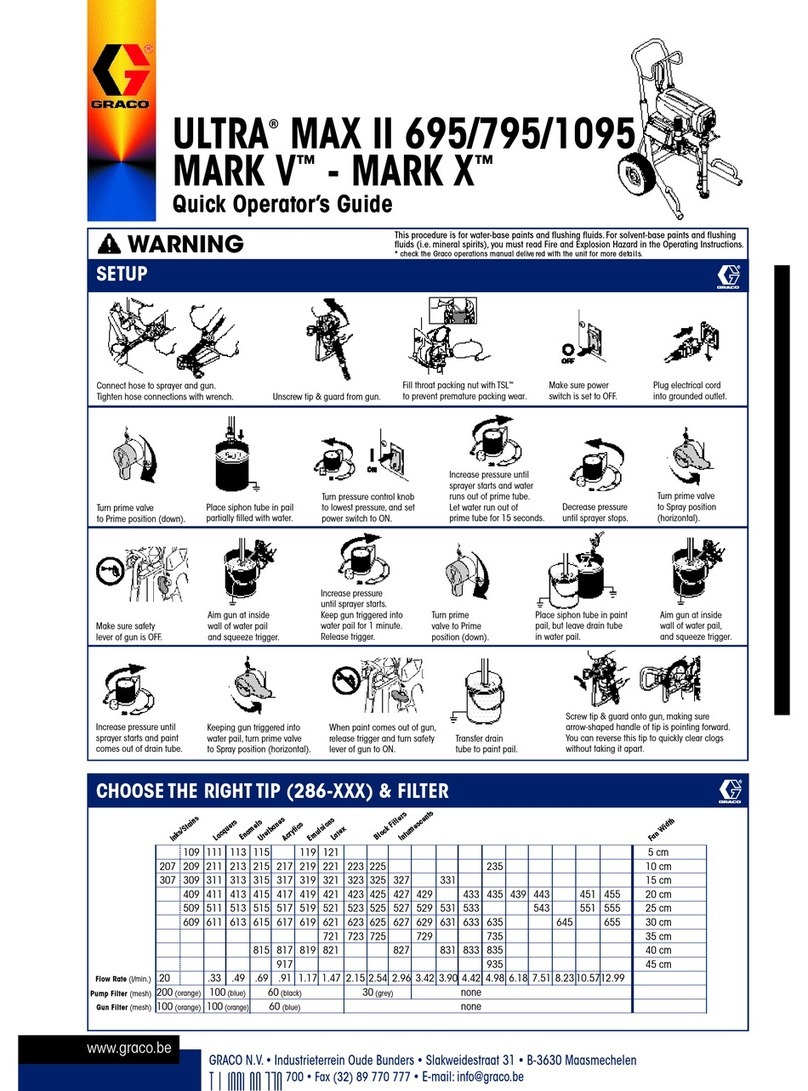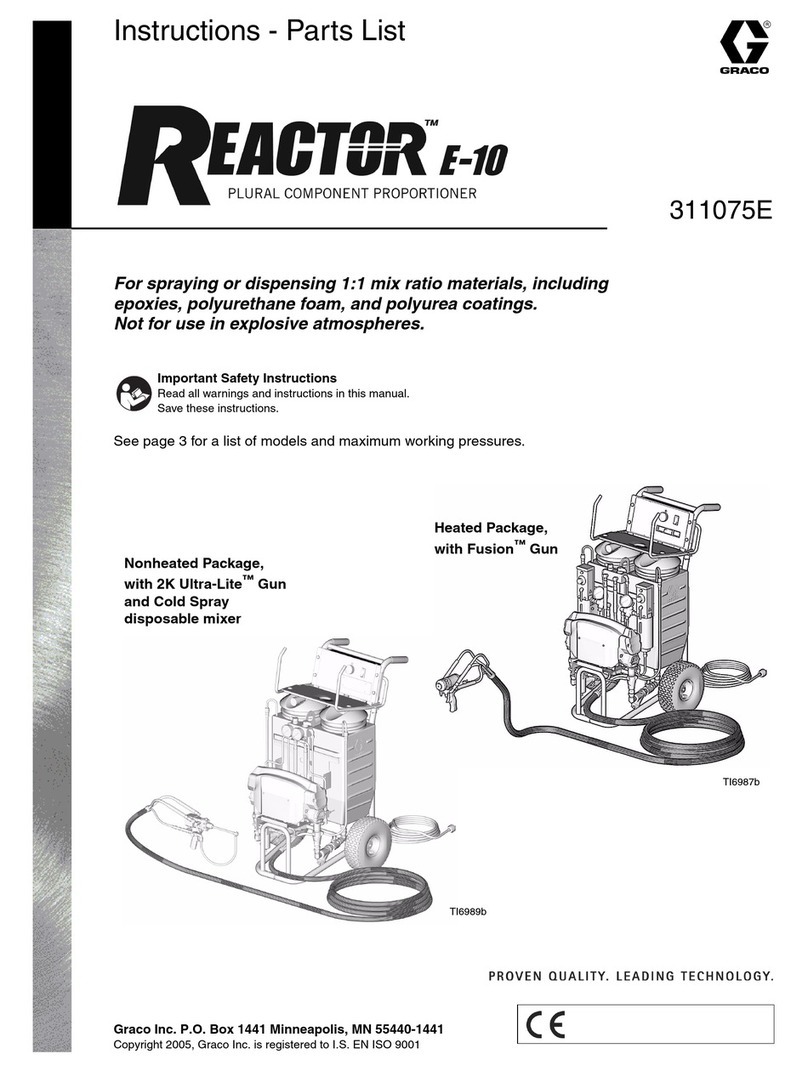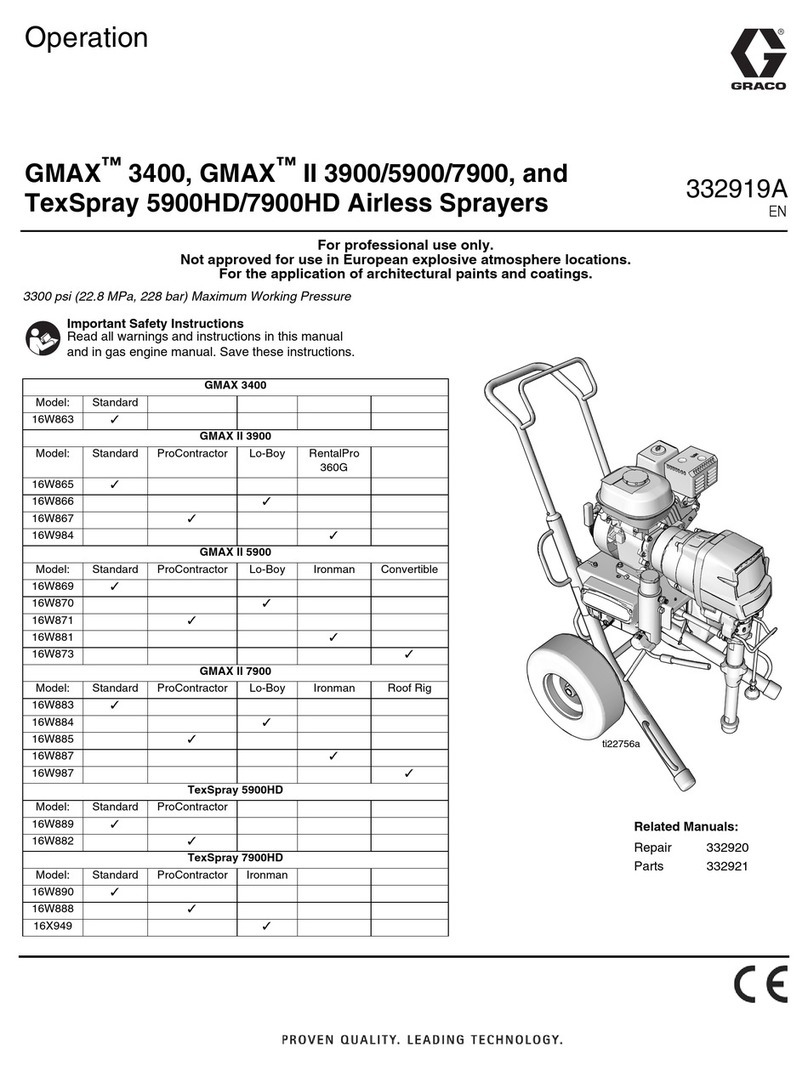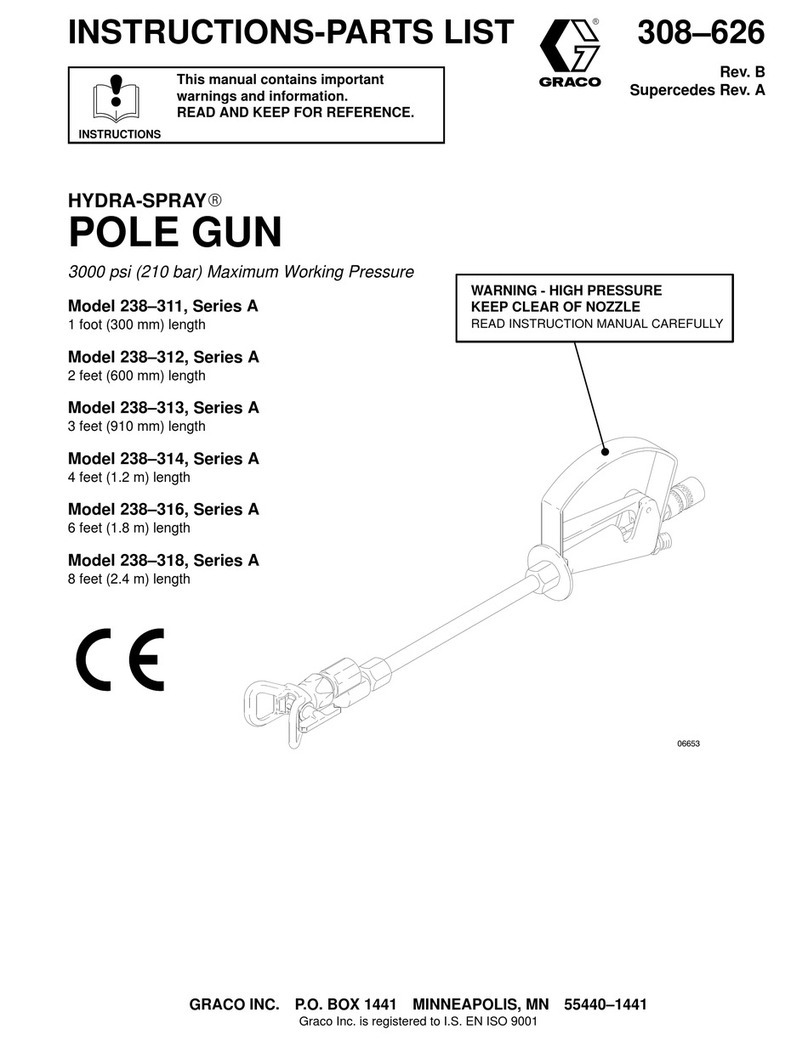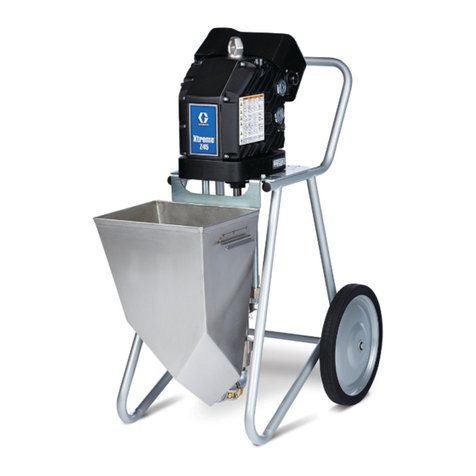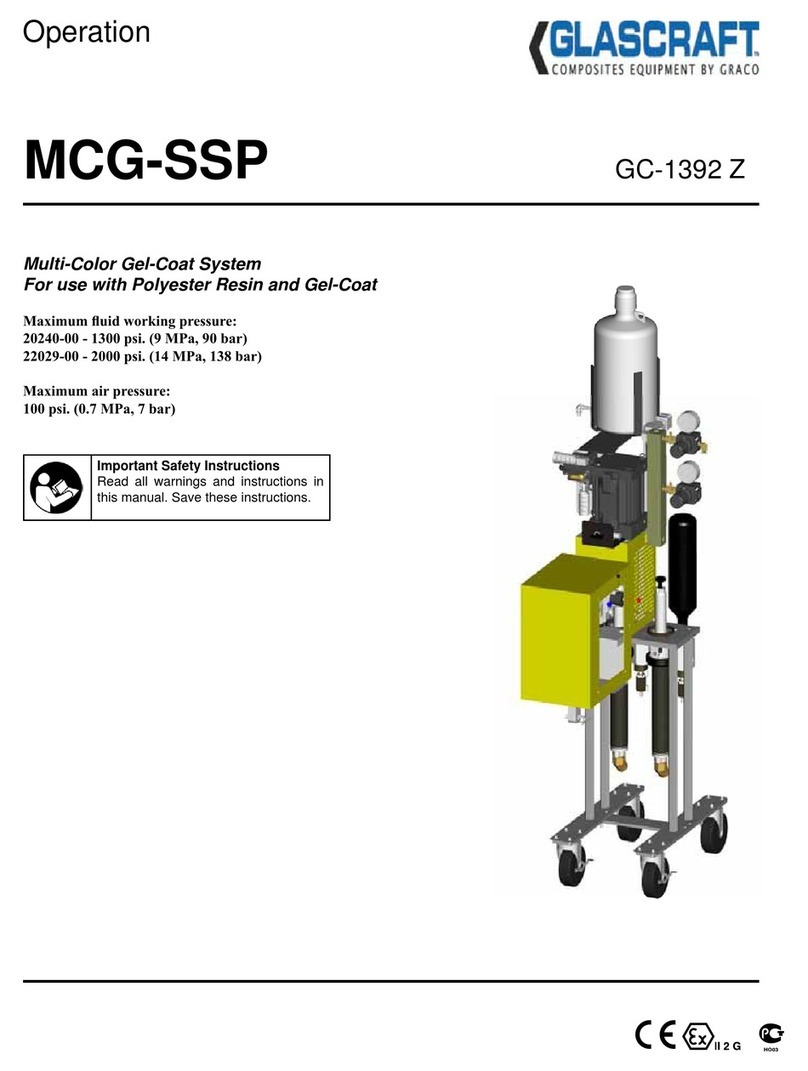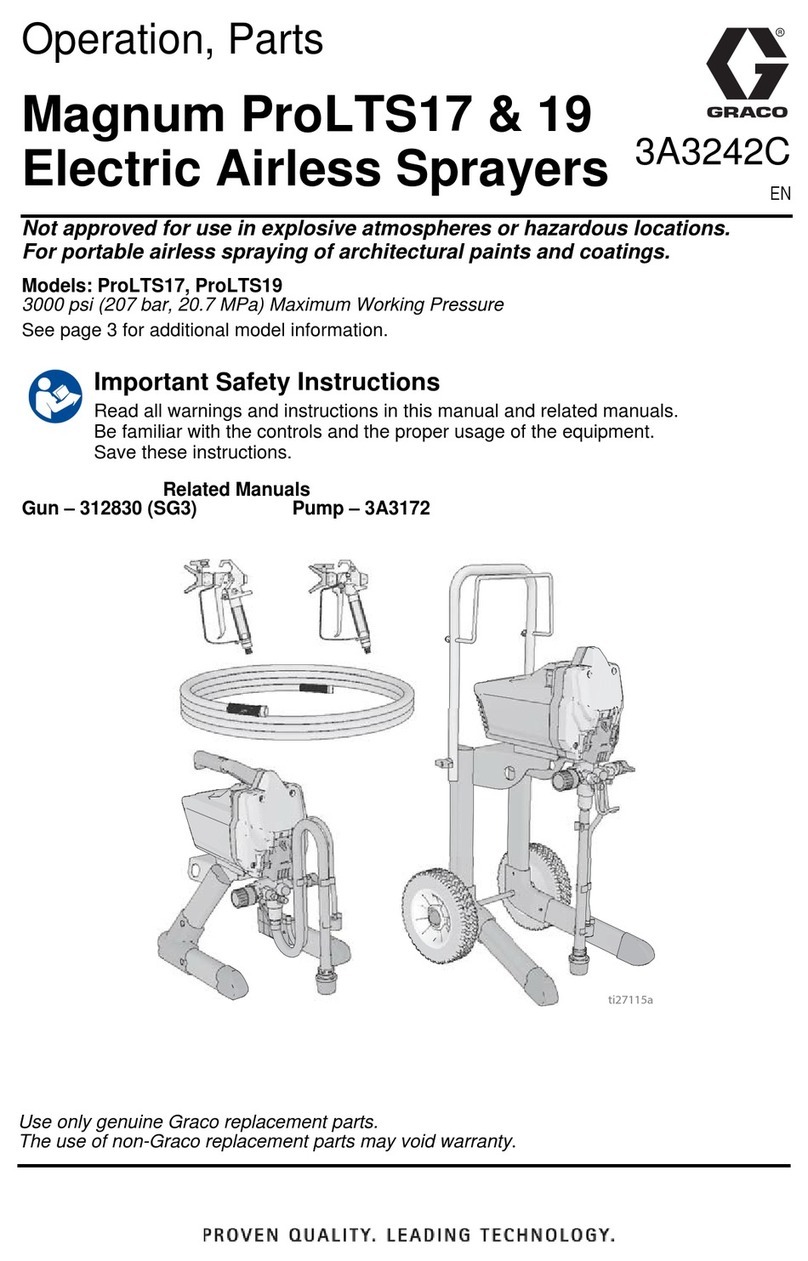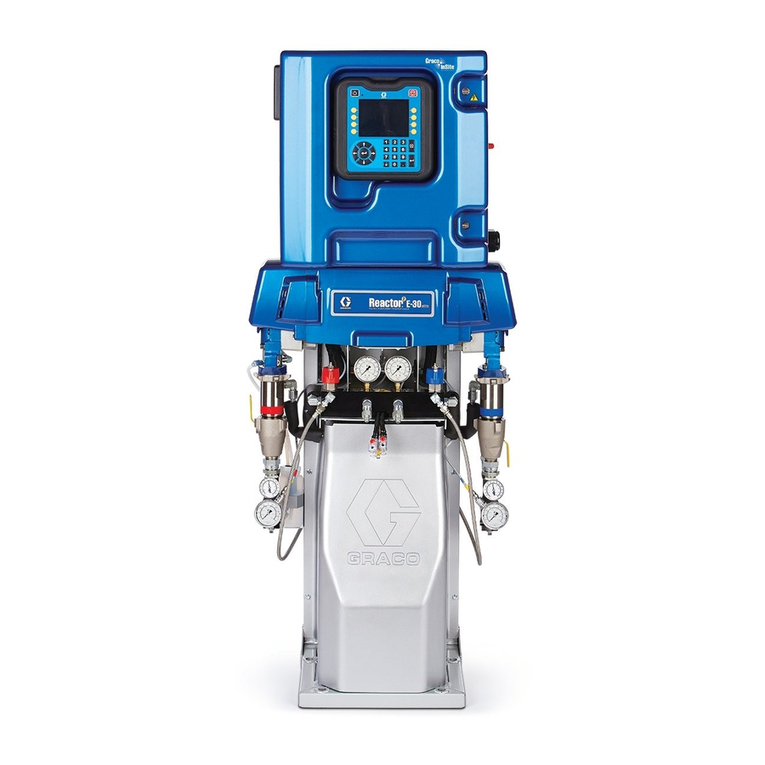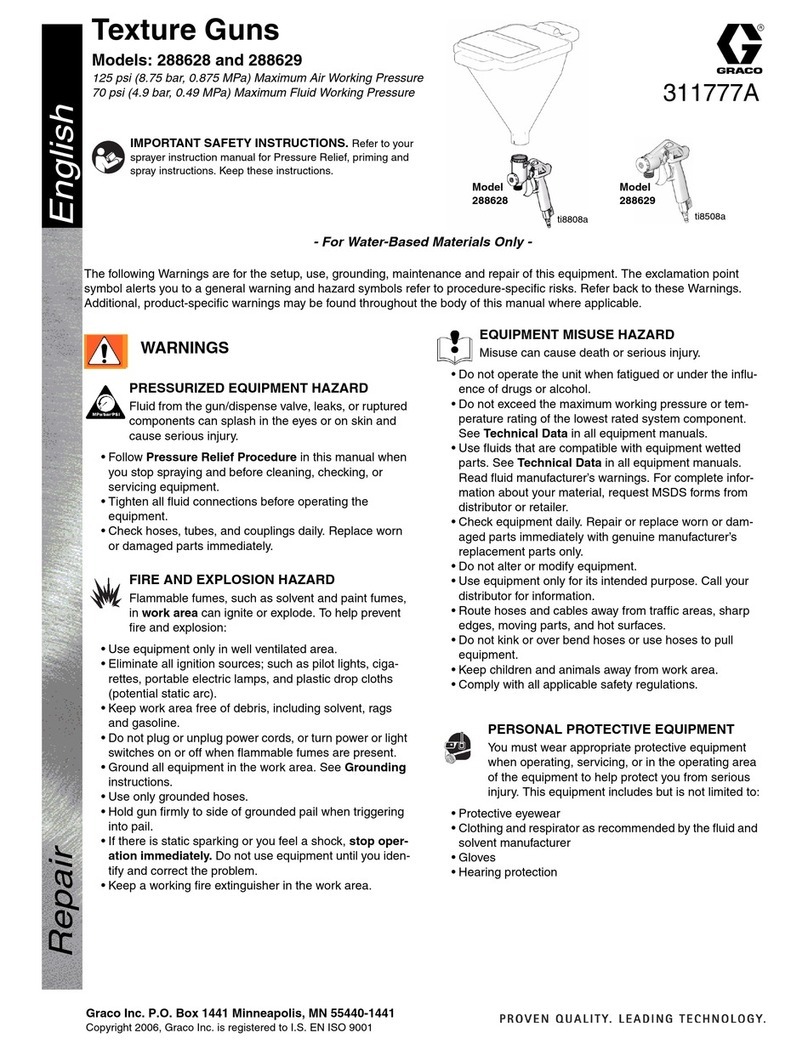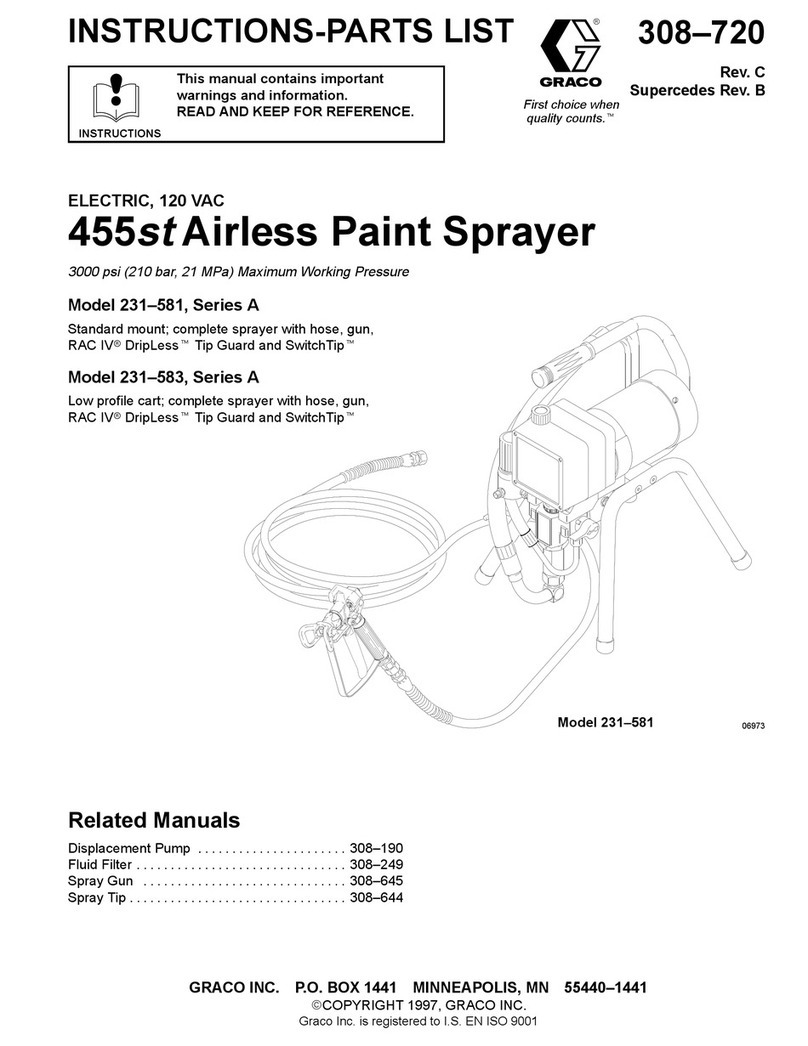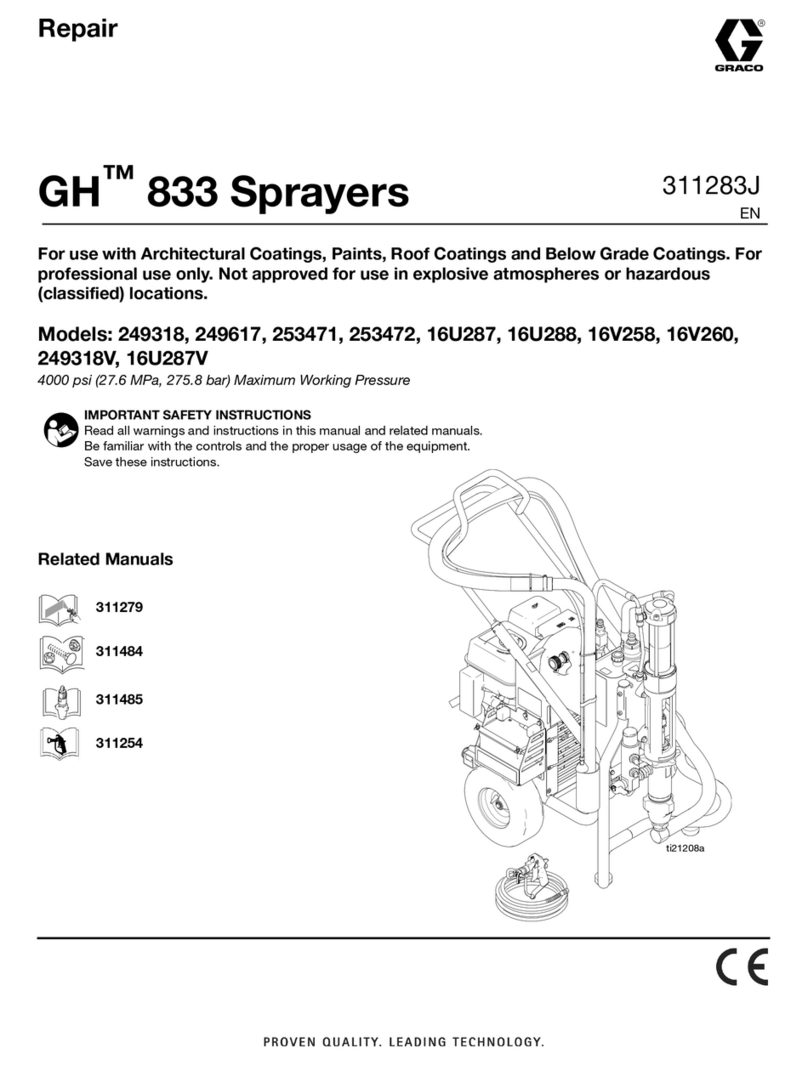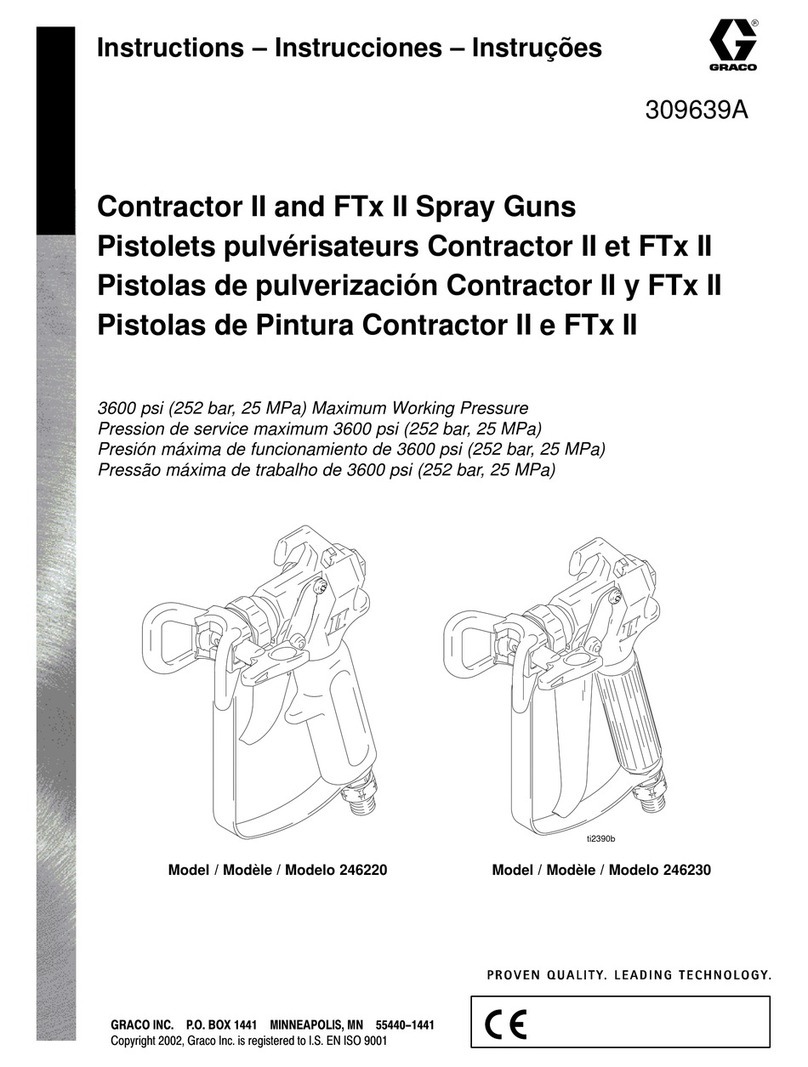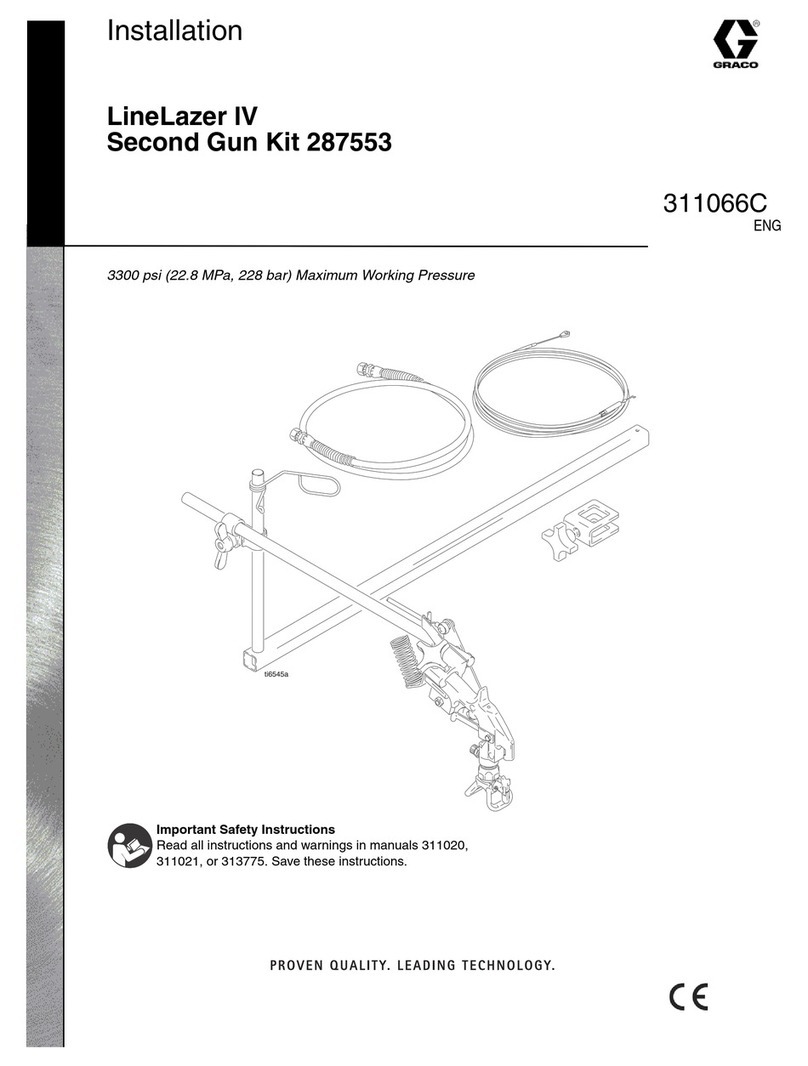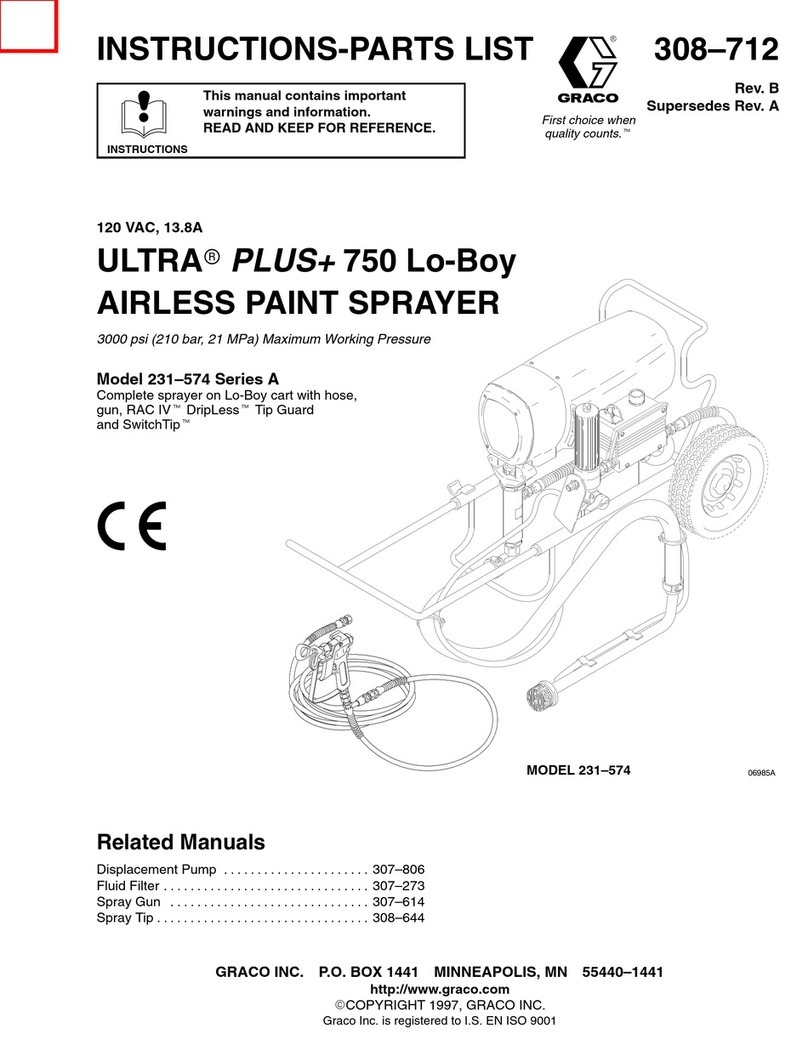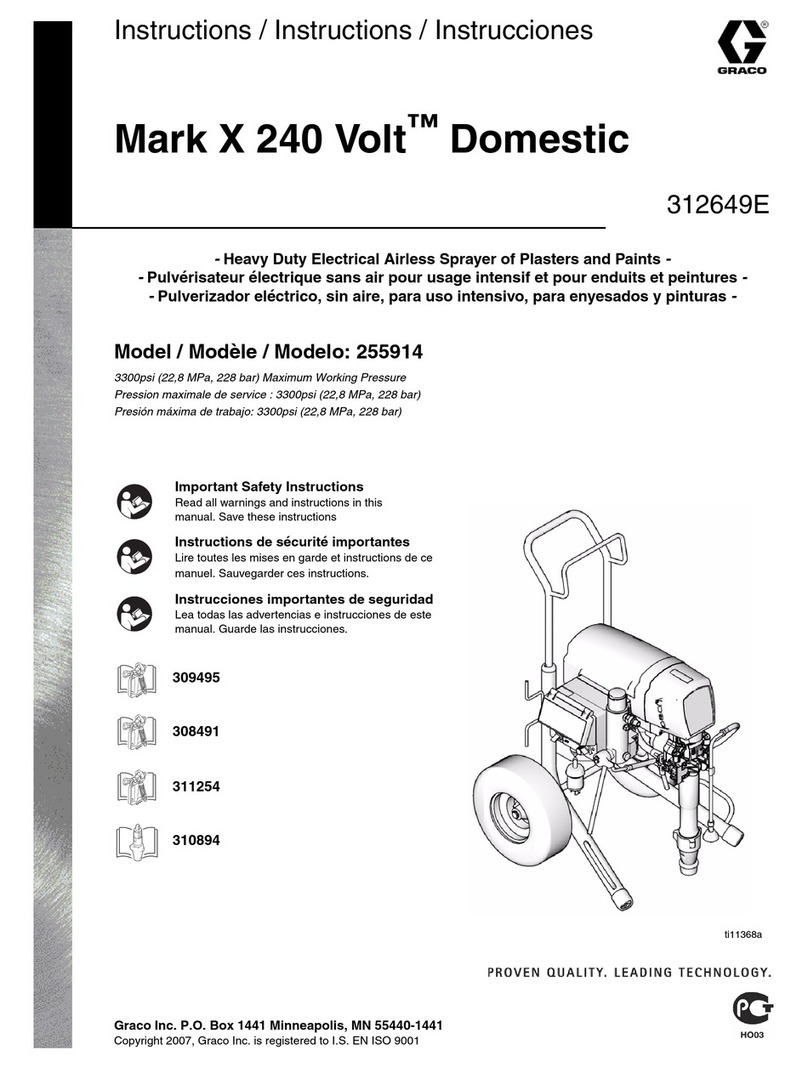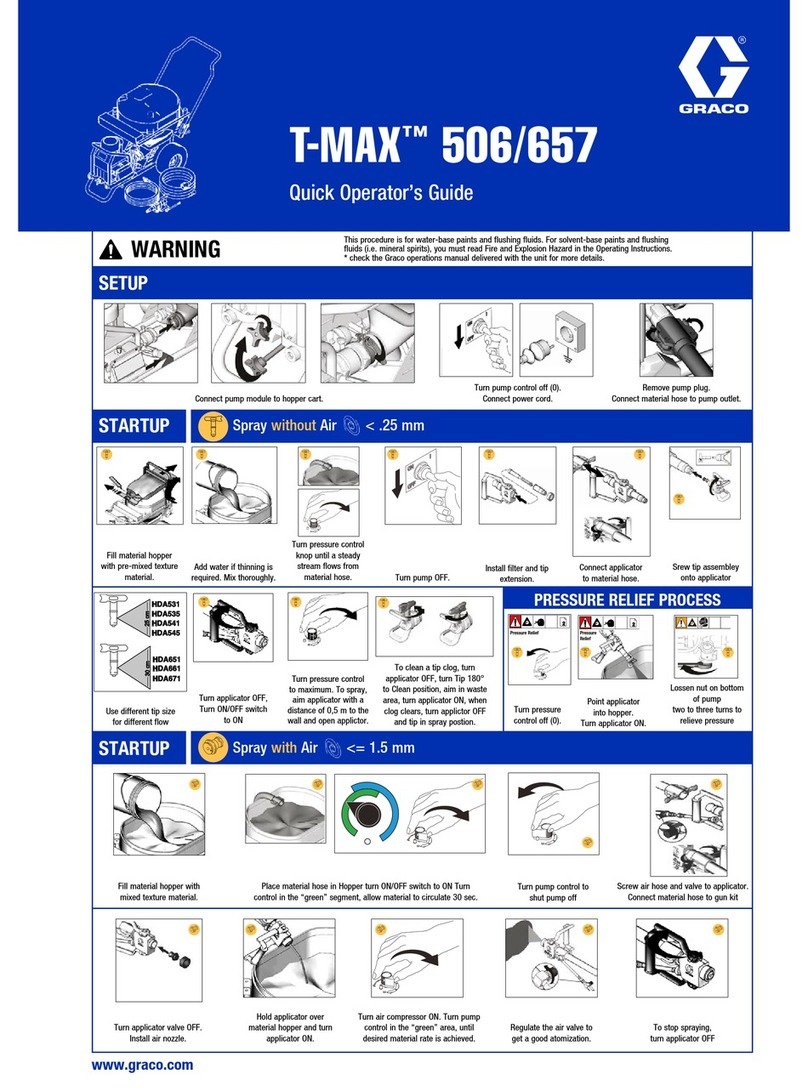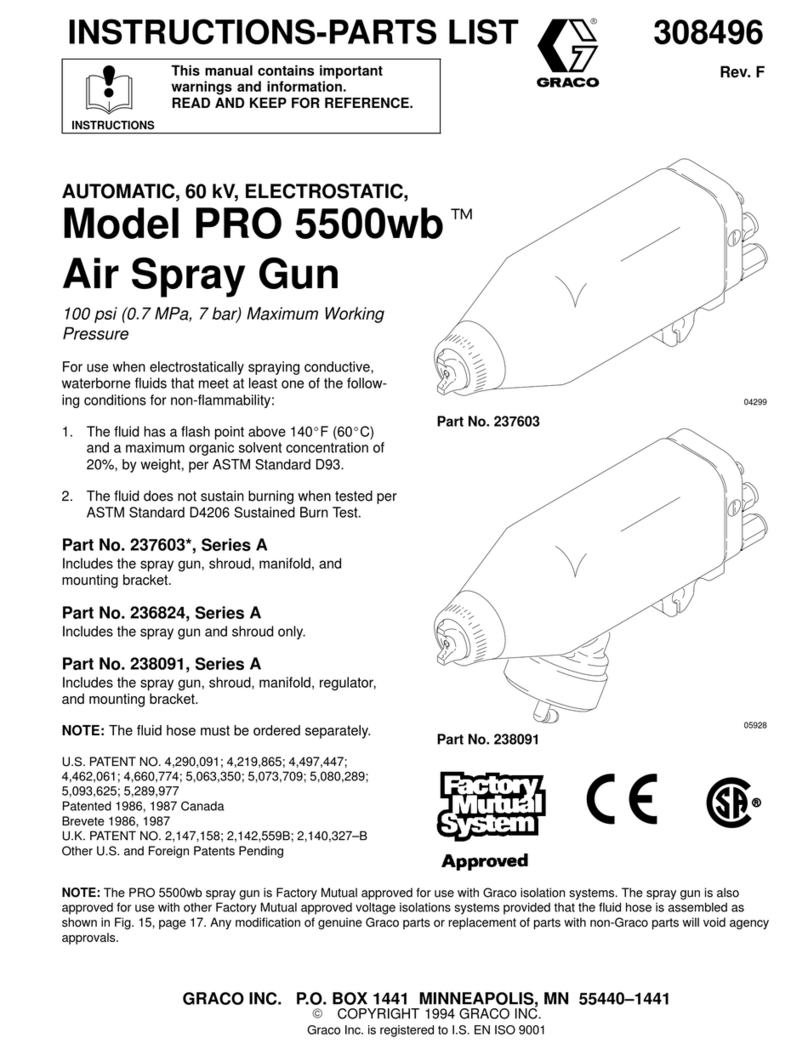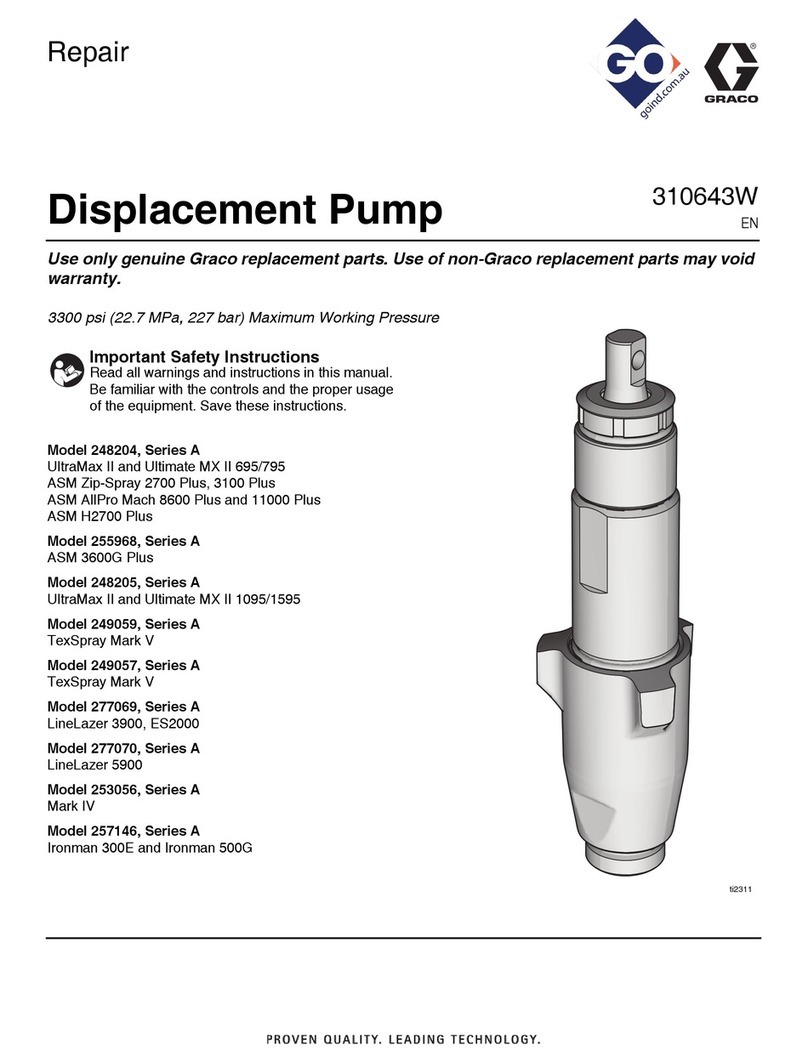
€QU/PMENT
MISUSE
HAZARD
General
Safety
overpressurizing, modifying parts, using incompatible
Any misuse of the spray equipmant or accBsBories, such as
chemicals and fluids, or using wornor damagedparts, can
cause them torupture and
result
inafluid injection, splashing
explosionor property damage.
in
the ayes or onthe skin, or other serious bodily injury, fire,
could cause
it
to malfunction.
NEVER alter or modify any part of this equipment; doing
so
worn or damaged pans immediately.
CiECK all sprayequipment regularly and repairorreplace
regardingthe use of protective clothing and equipment.
Readandfollow thefluid andsolvent manufacturer'sliterature
System
Pressure
This sprayer can develop
2750
psi (190,barJ MAXIMUM
accessoriesare rated to withstand the maximum working
WORKINGPRESSURE. Be sure that all spray equipmentand
pressureof this sprayer.
DO
NOT exceedthe maximumwork-
system.
ing pressure of any component oraccessory used
in
the
Fluid
and
Solvent
Compatibility
BE SUREthat all fluids andsolventsusedare chemicallycom-
the back cover. Always read the fluid and solvent manufac-
patible with the wettedparts shown inthe Technical Dataon
turer's literature before using them
in
this sprayer.
HOSE SAFETY
High pressure fluid inthe hoses can
be
vary dangerous.
If
the
damageor misuse, the highpressure sprayemittedfrom
it
can
hosa develops aleak, split or rupturedue toany kind of waar,
cause a
fluid
injection injury or other serious bodily injury or
property damage.
ALL FLUID HOSES MUST HAVESPRING GUARDS1The
spring guards help protect the hose
from
kinks
or
bends
at
or
close to thecoupling which can result in hose rupture.
TIGHTENall fluidconnectionssecurely beforeeach use.High
pressurespray to be emitted from the coupling.
pressure fluid Fan dislodge aloose coupling or allow high
NEVER use a damaged hose. Before each use, check the en-
tirehosefor cuts, leaks, abrasion.bulging cover, or damage or
exist, @lace the hose immediately,
DO
NOT try to recouple
movement of the hose couplings. If any of these conditions
highpressure hose ormend
it
with tape or anyother device. A
repaired hosecannot contain the high pressure fluid.
HANDLE AND ROUTE HOSES CAREFULLY.
Do
not pull on
hosestomove equipment.
Do
not usefluids
or
solventswhich
are not compatiblewith the innertube and cover of the hose.
00
NOT exposeGracohose to temperaturesabove 180°F
182"CI or below
4OF
(4'C).
Hose
Grounding Continuity
Proper hosegrounding continuity is essentialto maintaininga
groundedspray system. Checkthe electrical resistanceof your
air andfluid hoses
at
least once a week.If your hose doesnot
havea tagon
it
which specifies the maximum electrical
resistance, contact the hose supplier or manufacturerfor the
maximum resistance limits. Use
a
resistance meterin the ap-
propriate range for your hose to check the resistance. If the
resistanceexceeds the recommended limits, replace
it
im-
your system hazardous. Also readFIRE
OR
EXPLOSION
mediately. An ungroundedor poorly groundedhosecanmake
HAZARD.
FIRE
OR
EXPLOSION.HAZARD
through the pumpand hosa. If every part of the spray equlp-
Static electricity is created by the high velocity flow of fluid
ment is not properly grounded, sparking may occur, and the
systemmay become hazardous. Sparking mayalso occur
when plugging in or unplugging a power supply cord. Sparks
can ignite fumes from solvents and the fluid being sprayed.
dust particlesand other flammable substances, whether you,
are spraying indoors or outdoors, and can cause a fire or ex-
plosion andserious bodily injury and property damage.
Always plug the sprayer into an outlet at least
20
feet
16
m)
away from the sprayer and the spray area.
Do
not plug in or
any chanceof igniting fumes still in the air.
unplugany powersupply cords
in
thesprayarea whenthereis
while using this equipment, STOP SPRAYINGIMMEDI-
If you experience any static sparking
.or
even a slight shock
ATELY. Check the entire system for positive grounding. Do
not usethe systemagain until theproblemhas beenidentified
and corrected.
Grounding
To reducethe risk of static sparking, ground the sprayer and
all other spray equipment used or located
in
the sprayarea.
CHECK your local electrical code for detailed grounding
in-
structions for your area and type of equipment. BE SURE to
ground all of this spray equipment:
1.
2.
3.
4.
5.
6.
7.
Sprayer: plug the power supply cord, or extension cord,
eachequippedwithanundamagedthree-prongplug, into
aproperlygroundedoutlet.
Do
not useanadapter. All ex-
tension cords must have three wires and be rated for 15
amps.
Fluid
hoses: use only groundedhoseswith a maximumof
500
feet 1150 mJcombinedhoselengthtoensure ground-
ing continuity. Refer to Hose Grounding Continuity.
Spray
gun:
obtain grounding through connection to
a
properly grounded fluid hose and sprayer.
Objectbeing sprayed: accordingto local code.
Fluid
supply
container: according to local code.
All
solvent pails used when flushing, according to locsl
code. Useonlymetalpails, which areconductive.
DG
not
placethe pailona non-conductivesurface, suchas papor
or cardboard, which interrupts the grounding continuity.
To
maintaingrounding coptinuity when flushing or reliev-
ingpressure, alwaysholda metalpanof the gun firmlyto
the side of agrounded metalpail, then trigger the gun.
flushing
Safety
Reduce the risk of
a
fluid iniection injury, static sparking, or
splashing byfollowing the flushing procedure given on page
page
2,
andremovethe spray
tip
beforeflushing. Holdametal
12
of this manual. Followthe Pressure ReliefProcedure on
part
of
the gun firmlytothe side of agroundedmetalpailand
USB
the lowest possible fluid pressureduring flushing.
...
MOVING PARTS HAZARD
Moving pans can pinch or amputate your fingers or other
body pans. KEEPCLEAR
of
moving panswhenstarting or
operating the sprayer. Unplug
the
sprayer,and follow the
Pressure ReliefProcedureon page2 toprevent
it
from star-
ting accidentally.
IMPORTANT
ticularly the General Standards, Pan 1910, and the Construction Standards, Part 1926-should be consulted.
UnitedStatesGovernmentsafetystandardshave beenadopted underthe OccupationalSafetyand HealthAct, Thesestandards-par.
307-735
3
